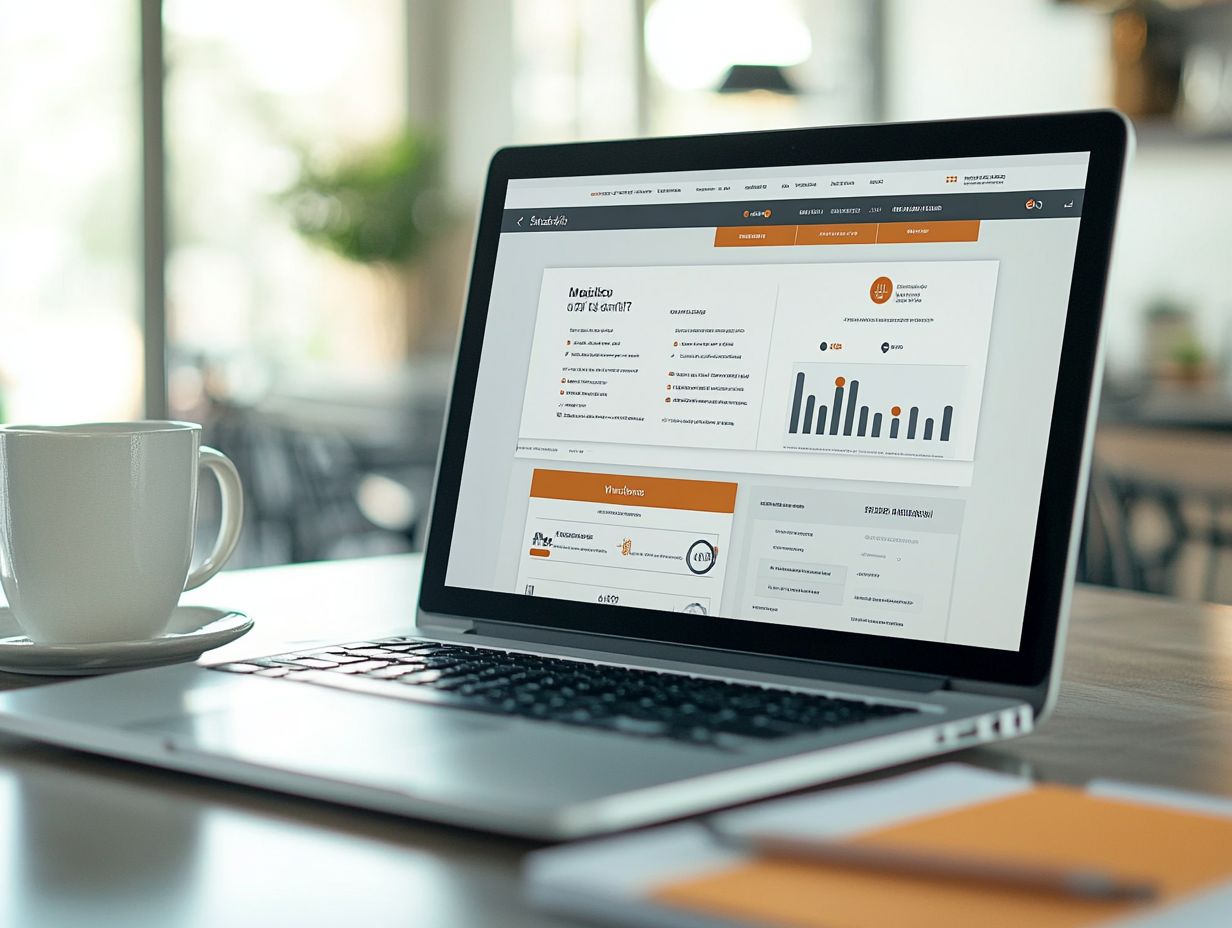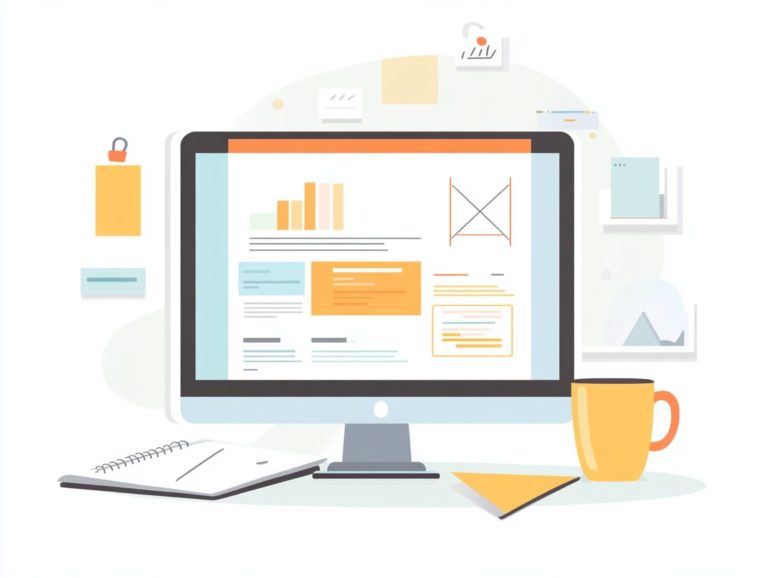“Optimizing Content for Conversion: Key Tips”
Let's Set Up Your Lead Generation Strategy
Fill out the form below, and our team will get in touch with you to create a tailored solution for your business.
In today’s digital landscape, mastering conversion optimization is vital for transforming casual visitors into devoted customers.
This exploration delves into the essential elements of what conversion truly means and why it holds significant importance. It highlights the key factors that impact content optimization, such as understanding your target audience, crafting compelling calls-to-action, and making deliberate design choices.
You’ll discover how to measure and analyze your conversion rates, implement mobile-friendly strategies, and harness the power of social proof.
Ready to boost your conversions? Let’s get started!
Contents
- Key Takeaways:
- Understanding Conversion Optimization
- Key Factors for Optimizing Content
- Let's Set Up Your Lead Generation Strategy
- Measuring and Analyzing Conversion Rates
- Let's Set Up Your Lead Generation Strategy
- Tips for Improving Conversion Rates
- Let's Set Up Your Lead Generation Strategy
- Frequently Asked Questions
- Ever wondered what it means to “optimize content for conversion”?
- Why is optimizing content for conversion important?
- What are some key tips for optimizing content for conversion?
- How can I understand my target audience better for content optimization?
- What is a call-to-action and how should it be used in content optimization?
- Why is it important to continuously test and analyze content for optimization?
Key Takeaways:

- Effective content optimization is vital for thriving in the digital space.
- Understanding your target audience and their intent is essential for effective content optimization.
- Using tools, metrics, and testing methods can help improve conversion rates and drive business growth.
Understanding Conversion Optimization
Understanding Conversion Optimization is crucial if you’re looking to enhance your online presence and achieve sustainable growth. By analyzing visitor data and optimizing conversion rates, you can turn casual website visitors into qualified leads, ultimately boosting your sales.
This process incorporates a range of strategies, such as A/B testing (comparing two versions of a webpage to see which one performs better), improving user experience, and fine-tuning your marketing campaigns, all tailored to meet the specific needs of your potential customers.
Whether you’re a sales representative or a marketer, grasping these concepts will enable you to effectively use techniques to improve conversion rates, ensuring that every facet of your digital marketing efforts is aligned to maximize your conversion potential.
Defining Conversion and Its Importance
Conversion is the art of transforming website visitors into qualified leads or customers. It holds immense significance in the success of your digital marketing strategy.
By understanding the various types of conversions—like sales and email opt-ins—you can enable your marketing teams and sales representatives to tailor their strategies with precision.
The conversion funnel serves as a crucial framework, guiding potential customers from the initial spark of awareness to the pivotal decision-making stage. As you monitor conversion rates and engage in lead tracking, you’ll be able to pinpoint bottlenecks and uncover opportunities for enhancement.
This awareness not only improves customer experiences but also drives overall business growth. It’s essential to grasp the intricacies of conversions to unlock their full potential and maximize your effectiveness in the competitive landscape.
Key Factors for Optimizing Content
To optimize your content effectively, it’s essential to understand user behavior, thoroughly analyze your traffic sources and traffic channels, and implement compelling marketing strategies.
These elements will significantly enhance the conversion rates on your website, ensuring you connect with your audience in a meaningful way.
Target Audience and User Intent
Identifying your target audience and understanding their user intent is crucial for successful content optimization and can significantly boost your conversion rates.
Let's Set Up Your Lead Generation Strategy
Fill out the form below, and our team will get in touch with you to create a tailored solution for your business.
By employing market research techniques like surveys, social media listening, and competitor analysis, you can uncover not just who your audience is, but what truly drives their behavior. Utilizing analytics tools allows you to delve deeper into user engagement metrics, illuminating which content resonates with your audience and understanding their value proposition.
Understanding user intent is vital for crafting a seamless website experience. It enables intuitive navigation and relevant calls to action, ultimately enhancing usability. Tailoring your content to address these specific needs ensures that your audience feels recognized and valued, increasing the likelihood of conversion and nurturing enduring loyalty.
Start analyzing your data today to see real results!
Effective Call-to-Actions

An effective call-to-action (CTA) is an essential element in any digital marketing campaign. It plays a crucial role in driving user engagement, shaping your conversion goals, and influencing response rates.
By guiding consumers toward the actions you desire, CTAs become powerful tools in maximizing your marketing strategies. When you design these prompts thoughtfully, you can significantly influence user behavior, resulting in higher response rates.
Best practices indicate that crafting compelling, clear messages is key. Using action-oriented language creates a sense of urgency and resonates with your audience’s needs. Placing CTAs strategically within your content—whether on landing pages, social media posts, or emails—enhances visibility and functionality, ensuring users are prompted at just the right moments.
Ultimately, using effective CTAs involves understanding your audience’s journey and shaping interactions that foster meaningful engagement. This can ultimately boost your lead generation efforts.
Design and Layout Considerations
Design and layout considerations are vital for enhancing user experience and optimizing website performance. These factors ultimately influence your conversion rates.
The visual elements of your website—like color schemes, typography, and images—are essential for capturing visitors’ attention and forming emotional connections. A well-structured layout streamlines navigation, making it easy for users to locate relevant information. This thoughtful design strategy enhances usability and shapes how users engage with your brand, encouraging them to explore more.
Incorporating marketing automation tools can elevate engagement by providing personalized experiences. High-converting pages thrive on clarity and simplicity. To boost usability, use white space effectively, ensuring your calls-to-action stand out and are intuitive for users.
Measuring and Analyzing Conversion Rates
Understanding your conversion rates is vital for success! It is crucial for anyone aiming to grasp the effectiveness of their marketing campaigns and enhance their conversion rate optimization strategies. By analyzing this data, you can unlock valuable insights that drive your business forward.
Tools and Metrics for Tracking Conversions
Using the right tools and metrics for tracking conversions enables you to gain valuable insights into visitor data and refine your conversion rate optimization efforts.
By leveraging popular analytics platforms like HubSpot (which provides comprehensive CRM capabilities for managing customer interactions) and Amazon with robust conversion tracking, or Hotjar, known for its heatmaps and session recordings, you must cultivate a deeper understanding of user behaviors and preferences.
Monitoring key metrics such as bounce rates, click-through rates, and conversion funnels is essential for identifying bottlenecks and optimizing the user experience to improve website traffic.
Let's Set Up Your Lead Generation Strategy
Fill out the form below, and our team will get in touch with you to create a tailored solution for your business.
Tools like Google Analytics are critical as they deliver vital data on traffic sources and user engagement, enabling you to make informed decisions that can lead to significant improvements in your conversion rates.
Tips for Improving Conversion Rates
Enhancing conversion rates is an ongoing journey that requires you to implement a range of strategies specifically designed for your audience. Take into account their behavior and feedback. Each adjustment you make is an opportunity to refine your approach, ensuring that you resonate deeply with your customers and drive meaningful results.
Optimizing Content for Mobile Devices

Optimizing content for mobile devices is essential in today’s digital landscape. A substantial number of users are online shoppers navigating websites through smartphones and tablets. It’s crucial to ensure that your pricing page is optimized for mobile.
This shift in user behavior demands attention and highlights the necessity of employing best practices for mobile optimization. These practices can significantly enhance your e-commerce conversion rates through effective marketing strategies.
By implementing responsive design, which makes your website look good on any device, you ensure that your site adapts effortlessly to various screen sizes. When paired with fast loading times, this responsiveness minimizes wait periods and reduces bounce rates.
User-friendly navigation is another critical element. When potential customers can easily browse products and complete transactions, their chances of converting rise dramatically. By prioritizing these facets, you create a more satisfying user experience, encouraging repeat visits and fostering brand loyalty.
Utilizing Social Proof and Testimonials
Social proof and customer testimonials serve as powerful catalysts for elevating response rates and amplifying lead generation efforts for your business.
By harnessing the experiences and insights of satisfied customers, you cultivate a robust sense of trust and credibility among potential clients. This trust plays a crucial role in influencing decisions, as individuals often look to the assessments of others before making a purchase commitment.
Different types of testimonials—such as video endorsements, written reviews, or detailed case studies—can prove particularly effective. Placing these endorsements strategically on landing pages, social media platforms, or within email campaigns greatly enhances their impact.
Understanding where and how to showcase these endorsements can significantly bolster your business’s reputation and overall appeal.
Implementing A/B Testing
Implementing A/B testing is essential for grasping user behavior and reaching your conversion goals with greater precision.
By systematically comparing different versions of web elements, you can identify what truly resonates with your audience. This might involve creating variations of landing pages, fine-tuning the wording of your calls-to-action, or experimenting with different images.
Once you have these elements in place, observing user interactions will yield invaluable insights. Metrics such as click-through rates, bounce rates, and conversion rates illuminate the preferences of your visitors.
By analyzing these results, you can refine your strategies. Focus on approaches that genuinely drive engagement and align with the needs of your target audience.
Let's Set Up Your Lead Generation Strategy
Fill out the form below, and our team will get in touch with you to create a tailored solution for your business.
Frequently Asked Questions
Ever wondered what it means to “optimize content for conversion”?
“Optimizing content for conversion” refers to the process of creating and designing content that encourages users to take a specific action, like making a purchase, filling out a form, or subscribing to a newsletter. It involves strategically placing elements and using language that leads to increased conversions.
Why is optimizing content for conversion important?

Optimizing content for conversion is crucial because it can significantly impact your business’s success. By converting more website visitors into customers or leads, you can increase revenue and grow your business. This process also helps you understand your target audience better, tailoring your content to their needs and preferences.
What are some key tips for optimizing content for conversion?
Some key tips include understanding your target audience, using persuasive language and visuals, incorporating clear calls-to-action, utilizing social proof, and continuously testing and analyzing your content to make improvements. Want to learn more? Check out our comprehensive guide on content optimization!
How can I understand my target audience better for content optimization?
To truly connect with your audience, do research on the market. Analyze your website’s data, get feedback from customers, and create buyer personas.
This approach provides insights into their demographics and interests. It also highlights their challenges, helping you tailor your content strategy.
What is a call-to-action and how should it be used in content optimization?
A call-to-action (CTA) is a clear request for users to take action, like “Buy Now” or “Subscribe.” Place it strategically and use persuasive language to boost conversions.
Your CTA should stand out visually. It must be easy for users to click or engage with.
Why is it important to continuously test and analyze content for optimization?
Testing and analyzing your content is essential for making informed decisions. Track metrics like click-through rates and conversions to spot areas for improvement.
Adjust your content to achieve better results and keep your audience engaged!






